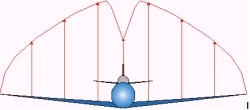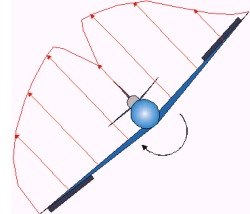|
How to Keep Your Wings Attached and Trousers Dry by David Lian |
||||
|
Failure Under Symmetrical Loads Symmetrical loads occur when both wings produce equal lift - for example, straight and level flight as shown below.
 What happens when one pulls up into a loop at say, 6Gs, in an aircraft which has a limit load factor of 6Gs? The load profile would perhaps look like:
 If the pilot decided to pull to the ultimate load factor of 9Gs (6G x 1.5), it would theoretically result in both wings failing simultaneously. In practice, variations in construction and/or material properties would probably mean one wing failing sooner than the other. So does it mean that as long as one pulls Gs up to but not beyond the limit load factor, everything will be okay? The answer is that it depends on the situation. In certain circumstances, pulling up to the limit load can still result in structural failure. The introductory anecdote alludes to this. Failure Under Assymmetrical Loads Suppose you're in a situation described at the start of this article - a high-G defensive spiral. Without roll inputs, the lift loading would be pretty much symmetrical as in the previous diagram except that the aircraft is banked and pitched nose down. Now, suppose the pilot decides to aggressively roll out of the bank while still pulling at the limit load factor (measured along the centreline). What happens then? Lift on the down-going wing is reduced while lift on the up-coming wing is increased as shown.
 |
 As far as the pilot is concerned, the accelerometer still shows 6Gs. But the up-coming wing experiences not only the 6Gs measured along the centreline but also the additional load from the downward deflected aileron. If the combined load factor exceeds 9G (ultimate load factor in this example), then the up-coming wing will fail. Rolling G Limit Let's look at another situation. If an aircraft has a maximum limit of 6Gs, what is the G limit for a barrel roll? Is it still 6Gs or something different? The first step is to recognise that barrel rolls involve simultaneous pitching and rolling of the aircraft - similar in concept to rolling out of a downward spiral. So this is a situation where an unwary pilot may overstress the aircraft, if he/she is unaware of the danger described in the preceding discussion. Without the benefit of fancy G-limiters, a simple rule of thumb to avoid becoming a lawn dart is to take 66% of the maximum G limit as the rolling G limit. For example, if the limit load factor is 6G, then the rolling G limit is 4G (6G x 0.66). The 33% reduction gives sufficient buffer to avoid structural failures during aggressive and simultaneous pitch/roll manoeuvering; where load onset can be rapid and catch unwary pilots offguard. What do you do if you want to roll aggressively but are already above the rolling G limit? Simply unload (move stick forward) the aircraft to the rolling G limit before whacking the stick to one side. Rest assured the aircraft flies much better with both wings attached! Until the next time an Antung University instructor bounces you, keep your wings attached and trousers dry! Background on writer David holds a bachelor's degree in aeronautical engineering with first class honours, and double master's degrees in aeronautics & astronautics, and business administration. A non-practicing commercial pilot, he regularly flies aerobatics in a SIAI Marchetti SF260 to keep his sinuses clear. Join a discussion forum on this article by clicking HERE.
|
|||
|
Copyright © 1997 - 2000 COMBATSIM.COM, INC. All Rights Reserved. Last Updated November 22nd, 1999 |
||||
